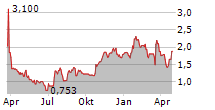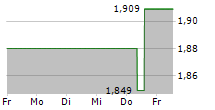CAMBRIDGE, Mass., Oct. 28, 2025 (GLOBE NEWSWIRE) -- Akebia Therapeutics®, Inc. (Nasdaq: AKBA), a biopharmaceutical company with the purpose to better the lives of people impacted by kidney disease, today announced that after meeting with the U.S. Food and Drug Administration (FDA) it has not come to alignment on a path forward for the design of the VALOR clinical trial for the use of vadadustat to treat anemia in patients with late-stage chronic kidney disease (CKD) not on dialysis. As a result, Akebia does not plan to initiate VALOR and therefore does not expect to pursue a broad label for Vafseo for CKD non-dialysis dependent patients.
Akebia recently completed a Type C meeting with the FDA. While Akebia has not yet received final meeting minutes from the face-to-face Type C meeting, based on the FDA feedback, Akebia believes regulatory alignment for such a trial would require a significantly larger number of patients than proposed, and accordingly would require meaningfully more time and cost to complete.
"Because we remain steadfast in our belief of the significant unmet need for an oral option to treat anemia in CKD patients not on dialysis, we are disappointed in the outcome of the meeting," said John P. Butler, Chief Executive Officer at Akebia. "We believe our decision not to pursue a broad NDD-CKD label, based on our discussion with the FDA, is in the best interests of our shareholders. We were encouraged by the discussion with FDA on smaller subgroups of CKD patients where we may be able to align on a potential clinical trial design and path forward. Importantly, everyone at Akebia will continue to work toward our goal to make Vafseo standard of care for patients on dialysis."
In the U.S., Vafseo® (vadadustat) is approved for the treatment of anemia due to CKD in adults who have been receiving dialysis for at least three months. Nephrologists in the U.S. began prescribing Vafseo to patients January 2025.
About Akebia Therapeutics
Akebia Therapeutics, Inc. is a fully integrated biopharmaceutical company with the purpose to better the lives of people impacted by kidney disease. Akebia was founded in 2007 and is headquartered in Cambridge, Massachusetts. For more information, please visit our website at www.akebia.com, which does not form a part of this release.
About Vafseo® (vadadustat) tablets
Vafseo® (vadadustat) tablets is a once-daily oral hypoxia-inducible factor prolyl hydroxylase inhibitor that activates the physiologic response to hypoxia to stimulate endogenous production of erythropoietin, increasing hemoglobin and red blood cell production to manage anemia. Vafseo is approved for use in 37 countries.
INDICATION
VAFSEO is indicated for the treatment of anemia due to chronic kidney disease (CKD) in adults who have been receiving dialysis for at least three months.
Limitations of Use
- VAFSEO has not been shown to improve quality of life, fatigue, or patient well-being.
- VAFSEO is not indicated for use:
- As a substitute for red blood cell transfusions in patients who require immediate correction of anemia.
- In patients with anemia due to CKD not on dialysis.
IMPORTANT SAFETY INFORMATION about VAFSEO (vadadustat) tablets
WARNING: INCREASED RISK OF DEATH, MYOCARDIAL INFARCTION, STROKE, VENOUS THROMBOEMBOLISM, and THROMBOSIS OF VASCULAR ACCESS.
VAFSEO increases the risk of thrombotic vascular events, including major adverse cardiovascular events (MACE).
Targeting a hemoglobin level greater than 11 g/dL is expected to further increase the risk of death and arterial and venous thrombotic events, as occurs with erythropoietin stimulating agents (ESAs), which also increase erythropoietin levels.
No trial has identified a hemoglobin target level, dose of VAFSEO, or dosing strategy that does not increase these risks.
Use the lowest dose of VAFSEO sufficient to reduce the need for red blood cell transfusions.
CONTRAINDICATIONS
- Known hypersensitivity to VAFSEO or any of its components
- Uncontrolled hypertension
WARNINGS AND PRECAUTIONS
- Increased Risk of Death, Myocardial Infarction (MI), Stroke, Venous Thromboembolism, and Thrombosis of Vascular Access
A rise in hemoglobin (Hb) levels greater than 1 g/dL over 2 weeks can increase these risks. Avoid in patients with a history of MI, cerebrovascular event, or acute coronary syndrome within the 3 months prior to starting VAFSEO. Targeting a Hb level of greater than 11 g/dL is expected to further increase the risk of death and arterial and venous thrombotic events. Use the lowest effective dose to reduce the need for red blood cell (RBC) transfusions. Adhere to dosing and Hb monitoring recommendations to avoid excessive erythropoiesis.
- Hepatotoxicity
Hepatocellular injury attributed to VAFSEO was reported in less than 1% of patients, including one severe case with jaundice. Elevated serum ALT, AST, and bilirubin levels were observed in 1.8%, 1.8%, and 0.3% of CKD patients treated with VAFSEO, respectively. Measure ALT, AST, and bilirubin before treatment and monthly for the first 6 months, then as clinically indicated. Discontinue VAFSEO if ALT or AST is persistently elevated or accompanied by elevated bilirubin. Not recommended in patients with cirrhosis or active, acute liver disease.
- Hypertension
Worsening of hypertension was reported in 14% of VAFSEO and 17% of darbepoetin alfa patients. Serious worsening of hypertension was reported in 2.7% of VAFSEO and 3% of darbepoetin alfa patients. Cases of hypertensive crisis, including hypertensive encephalopathy and seizures, have also been reported in patients receiving VAFSEO. Monitor blood pressure. Adjust anti-hypertensive therapy as needed.
- Seizures
Seizures occurred in 1.6% of VAFSEO and 1.6% of darbepoetin alfa patients. Monitor for new-onset seizures, premonitory symptoms, or change in seizure frequency.
- Gastrointestinal (GI) Erosion
Gastric or esophageal erosions occurred in 6.4% of VAFSEO and 5.3% of darbepoetin alfa patients. Serious GI erosions, including GI bleeding and the need for RBC transfusions, were reported in 3.4% of VAFSEO and 3.3% of darbepoetin alfa patients. Consider this risk in patients at increased risk of GI erosion. Advise patients about signs of erosions and GI bleeding and urge them to seek prompt medical care if present.
- Serious Adverse Reactions in Patients with Anemia Due to CKD and Not on Dialysis
The safety of VAFSEO has not been established for the treatment of anemia due to CKD in adults not on dialysis and its use is not recommended in this setting. In large clinical trials in adults with anemia of CKD who were not on dialysis, an increased risk of mortality, stroke, MI, serious acute kidney injury, serious hepatic injury, and serious GI erosions was observed in patients treated with VAFSEO compared to darbepoetin alfa.
- Malignancy
VAFSEO has not been studied and is not recommended in patients with active malignancies. Malignancies were observed in 2.2% of VAFSEO and 3.0% of darbepoetin alfa patients. No evidence of increased carcinogenicity was observed in animal studies.
ADVERSE REACTIONS
- The most common adverse reactions (occurring at = 10%) were hypertension and diarrhea.
DRUG INTERACTIONS
- Iron supplements and iron-containing phosphate binders: Administer VAFSEO at least 1 hour before products containing iron.
- Non-iron-containing phosphate binders: Administer VAFSEO at least 1 hour before or 2 hours after non-iron-containing phosphate binders.
- BCRP substrates: Monitor for signs of substrate adverse reactions and consider dose reduction.
- Statins: Monitor for statin-related adverse reactions. Limit the daily dose of simvastatin to 20 mg and rosuvastatin to 5 mg.
USE IN SPECIFIC POPULATIONS
- Pregnancy: May cause fetal harm.
- Lactation: Breastfeeding not recommended until two days after the final dose.
- Hepatic Impairment: Not recommended in patients with cirrhosis or active, acute liver disease.
Please note that this information is not comprehensive. Please click here for the Full Prescribing Information, including BOXED WARNING and Medication Guide.
Forward-Looking Statements
Statements in this press release regarding Akebia Therapeutics, Inc.'s ("Akebia's") strategy, plans, prospects, expectations, beliefs, intentions and goals are forward-looking statements within the meaning of the U.S. Private Securities Litigation Reform Act of 1995, as amended, and include, but are not limited to, statements regarding: Akebia's plans and expectations to not initiate the VALOR clinical trial for the use of vadadustat to treat anemia in patients with late-stage CKD not on dialysis and to not pursue a broad label for Vafseo for CKD non-dialysis dependent patients; Akebia's beliefs and expectations about feedback from the FDA, including that it has not come to alignment on a path forward for the design of VALOR and that it believes that regulatory alignment for the VALOR trial would require a significantly larger number of patients than proposed and meaningfully more time and cost to complete; Akebia's beliefs about the significant unmet need for an oral option to treat anemia in CKD patients not on dialysis; Akebia's beliefs that its decision not to pursue a broad NDD-CKD label is in the best interests of its shareholders; Akebia's expectations about its discussions with the FDA with respect to smaller subgroups of CKD patients where it may be able to align on a potential clinical trial design and path forward; and Akebia's plans to work toward its goal to make Vafseo standard of care for patients on dialysis. The terms "intend," "believe," "plan," "goal," "potential," "anticipate, "estimate," "expect," "future," "will," "continue," derivatives of these words, and similar references are intended to identify forward-looking statements, although not all forward-looking statements contain these identifying words. Actual results, performance or experience may differ materially from those expressed or implied by any forward-looking statement as a result of various risks, uncertainties and other factors, including, but not limited to, risks associated with: the potential therapeutic benefits, safety profile, and effectiveness of Vafseo; the results of preclinical and clinical research; decisions made by health authorities, such as the FDA, with respect to regulatory filings and other interactions; the potential demand and market potential and acceptance of, as well as coverage and reimbursement related to, Vafseo, including estimates regarding the potential market opportunity; the competitive landscape for Vafseo, including generic entrants and the timing thereof; the ability of Akebia to attract and retain qualified personnel; Akebia's ability to achieve and maintain profitability and to maintain operating expenses consistent with its operating plan; manufacturing, supply chain and quality matters and any recalls, write-downs, impairments or other related consequences or potential consequences; early termination of any of Akebia's collaborations; and changes in the geopolitical environment and uncertainty surrounding U.S. trade policy on tariffs. Other risks and uncertainties include those identified under the heading "Risk Factors" in Akebia's Quarterly Report on Form 10-Q for the quarter ended June 30, 2025, and other filings that Akebia may make with the U.S. Securities and Exchange Commission in the future. These forward-looking statements (except as otherwise noted) speak only as of the date of this press release, and, except as required by law, Akebia does not undertake, and specifically disclaims, any obligation to update any forward-looking statements contained in this press release.
Akebia Therapeutics® and Vafseo® are registered trademarks of Akebia Therapeutics, Inc.
Akebia Therapeutics Contact
Mercedes Carrasco
mcarrasco@akebia.com



